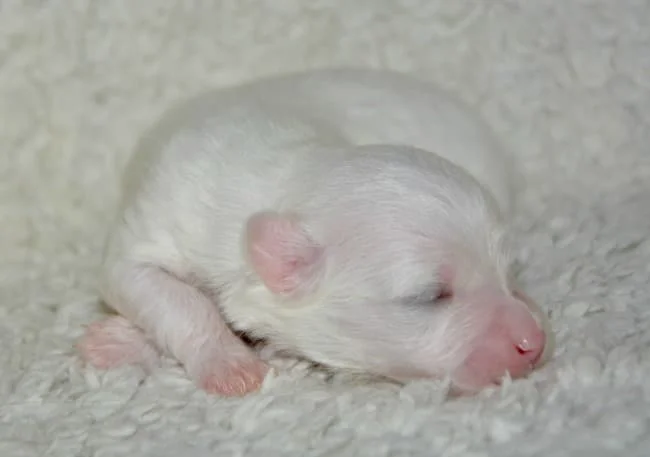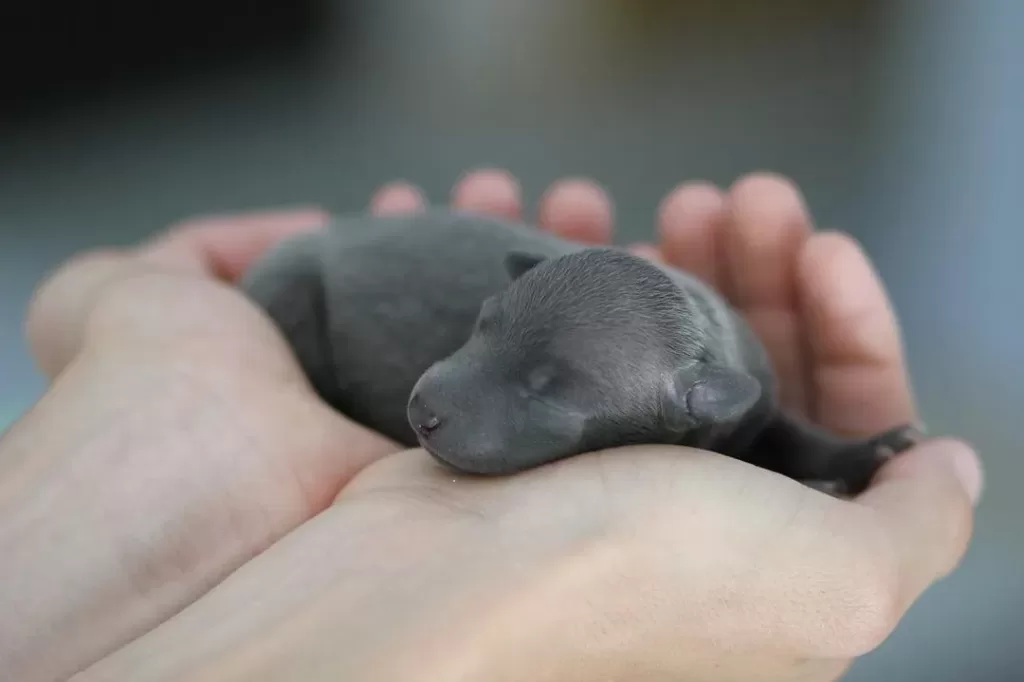How to Keep Newborn Large Breed Puppies Warm? The arrival of newborn puppies is a joyous occasion, but it also brings a critical responsibility: ensuring their warmth and well-being. Newborn puppies face significant challenges in regulating their body temperature, particularly during the first few weeks of life.
Table of Contents
This article delves into effective methods and strategies to keep these vulnerable pets warm and safe, providing pet owners with the knowledge they need to nurture their new companions.
1. Understanding the Temperature Needs of Newborn Puppies
Newborn puppies lack the ability to regulate their own body temperature, making them dependent on external heat sources. The mother dog plays a vital role in providing natural warmth, but human intervention is often necessary. Maintaining an ideal temperature range in the whelping box is crucial for the puppies’ comfort and development.
Newborn puppies are born with an immature thermoregulatory system, making them heavily reliant on their mother and environment for warmth. In the absence of their mother’s heat, it’s up to the breeder or pet owner to provide a controlled climate.
For instance, a breeder may notice the mother dog is unable to stay with her puppies due to health complications; thus, they must step in to maintain the whelping box at the recommended 85-90°F (29.5-32°C) for the first week, gradually lowering to 75°F (24°C) by the fourth week.
2. Methods for Keeping Newborn Puppies Warm
There are several heat sources available for keeping puppies warm, such as heat lamps, heating pads with adjustable thermostats, and microwavable warmers. Each method has its advantages and drawbacks, and it’s essential to use them safely to prevent burns or overheating. Regularly monitoring the puppies’ body temperature with a puppy-safe thermometer is also critical.
Various heating devices can be employed to provide warmth for puppies. A common scenario is the use of a heat lamp positioned safely above the whelping box, providing a consistent heat source without direct contact.
Another example is a breeder using a heating pad on the lowest setting, covered with a blanket to prevent direct contact with the puppies’ skin, ensuring they are cozy without the risk of overheating.
3. Ensuring a Cozy Environment: Bedding and Insulation
The right bedding materials, like fleece blankets or vet-approved heat pads, provide insulation and comfort. Additional measures, such as insulating panels or draft screens, can help maintain a warm microclimate within the whelping box.
The choice of bedding is crucial for insulation and comfort. A pet owner might choose fleece blankets that are easy to clean and provide soft, warm bedding for the puppies. To prevent drafts, they might place the whelping box in a corner and use draft screens. This creates a snug environment that mimics the warmth and security of the mother’s embrace.
4. Essential Care Practices for Newborn Puppies’ Well-being
Post-natal care routines, including regular health checks and hygiene practices, are vital for newborn puppies. Adequate nutrition is also essential, and supplemental feeding may be necessary, with guidance from a veterinarian.
Post-natal care is about more than just warmth. It encompasses hygiene, nutrition, and regular veterinary checks. A scenario here could involve a pet owner keeping a diligent schedule for feeding and cleaning, ensuring each puppy is thriving. If a puppy is not gaining weight, the owner may consult a vet for advice on supplemental feeding.
5. Gradual Transition to Room Temperature: Preparing Puppies for the Real World
As puppies grow, they need to adapt to normal room temperatures. A pet owner might start this process by turning off the heat sources for short periods during the day, allowing the puppies to experience slight variations in temperature.
This gradual transition helps them develop their own thermoregulatory capabilities.
6. Special Considerations for Keeping Large Breed Puppies Warm
Large breed puppies may have unique challenges when it comes to staying warm. They may be more susceptible to temperature-related issues, requiring special attention.
Large breed puppies, due to their rapid growth and larger surface area, lose heat quickly and require more energy to stay warm. It’s crucial to maintain the whelping box temperature between 85-90°F (29.5-32°C) during their first week of life, gradually reducing to around 75°F (24°C) by the fourth week.
For instance, a breeder raising a litter of Great Danes, a large breed known for its significant size even as puppies, would need to ensure that the heat source covers the larger area effectively. They might use two heating pads instead of one, ensuring each pad is set to a safe temperature of around 100°F (37.8°C) and covered with soft blankets to prevent direct contact with the puppies’ skin.
In another scenario, a pet owner with a litter of Bernese Mountain Dog puppies might invest in puppy-sized sweaters or jackets to provide additional warmth when the puppies are out of their nest for feeding or cleaning. These garments should be snug but not restrictive, allowing the puppies to move freely without discomfort.
Moreover, it’s important to monitor the puppies for signs of being too cold, such as persistent curling up, shivering, or lethargy. If such signs are observed, the breeder or owner should immediately adjust the heat sources or provide additional insulation.
For example, if the ambient temperature drops suddenly due to weather changes, extra layers of fleece blankets might be added to the whelping box, or the room’s thermostat could be adjusted to compensate for the drop in temperature
Why temperature is so critical?
Dogs are warm-blooded, meaning they can maintain a certain body temperature. For adult dogs, the normal body temperature ranges from 99.5 F to 102.5 F.
Newborn Puppies cannot successfully control body temperature in the first weeks of their lives, so they need help to stay safe and warm.
During the first week, the puppy’s body temperature may drop below 95 F. Over the next two weeks it will slowly rise to 98 F.
After the puppy reaches one month of age, their body temperature drops to the normal body temperature of adult dogs.
If a puppy is allowed to stay too cold, her digestion will be affected. She may find it very difficult to do nursing or suffer from a compromised immune system.3 Proper warmth is important for new babies!

Provide artificial warmth
Regardless of whether the puppy is orphaned or surrounded by the mother, some extra heating may be the answer to keeping the newborn warm, especially in the fall and winter.

Depending on the location and equipment of the shelter, you can add something like a hot water bottle over the blankets or buy a smaller heater.
Electric heaters can be used outside if dogs are sleeping in a dry area.
Change the bedding often
Since newborn puppies do not move very far, they go to the bathroom to sleep. I.e. towels or blankets get wet.
Wet material does not retain heat well, so you should change the bedding material at least once every day.
Also Read: Why isn’t My Male Dog Interested in Mating?
If you observe rain, wrap the newborn puppy immediately with a dry towel until dry – and at this point dry and replace everything in the sleeping area.
So, at what age should a puppy be kept warm?
These puppies need to be closely monitored and kept warm from birth to the first week.
Each week, their rectal temperature rises. The safe age to complete consistent monitoring is 4 weeks.
Once your puppy has reached this stage, all you need to do is make sure the environment around your puppy is good for them and not expose them to any extreme temperature.
| Puppy Age | Room Temperature |
| NewBorn to 7 Days | 85 -95 F |
| Day 8 to Day 14 | 80 – 85 F |
| Day 15 to Day 21 | 75 – 80 F |
| Day 22 to Day 28 | 70 -75 F |
Conclusion
The well-being of newborn puppies hinges on the careful management of their environment, particularly their need for warmth. By following the strategies outlined in this article, pet owners and breeders can provide the best possible start for these precious lives. Remember, the goal is to create a nurturing space that supports the puppies’ growth and development into healthy and happy dogs.
This expanded guide offers a deeper understanding of the nuances involved in caring for newborn puppies. By incorporating these insights and real-life examples, readers can feel equipped to handle the challenges and rewards that come with raising a litter. The article is designed to be the ultimate resource for anyone looking to ensure the health and comfort of their newborn puppies.

